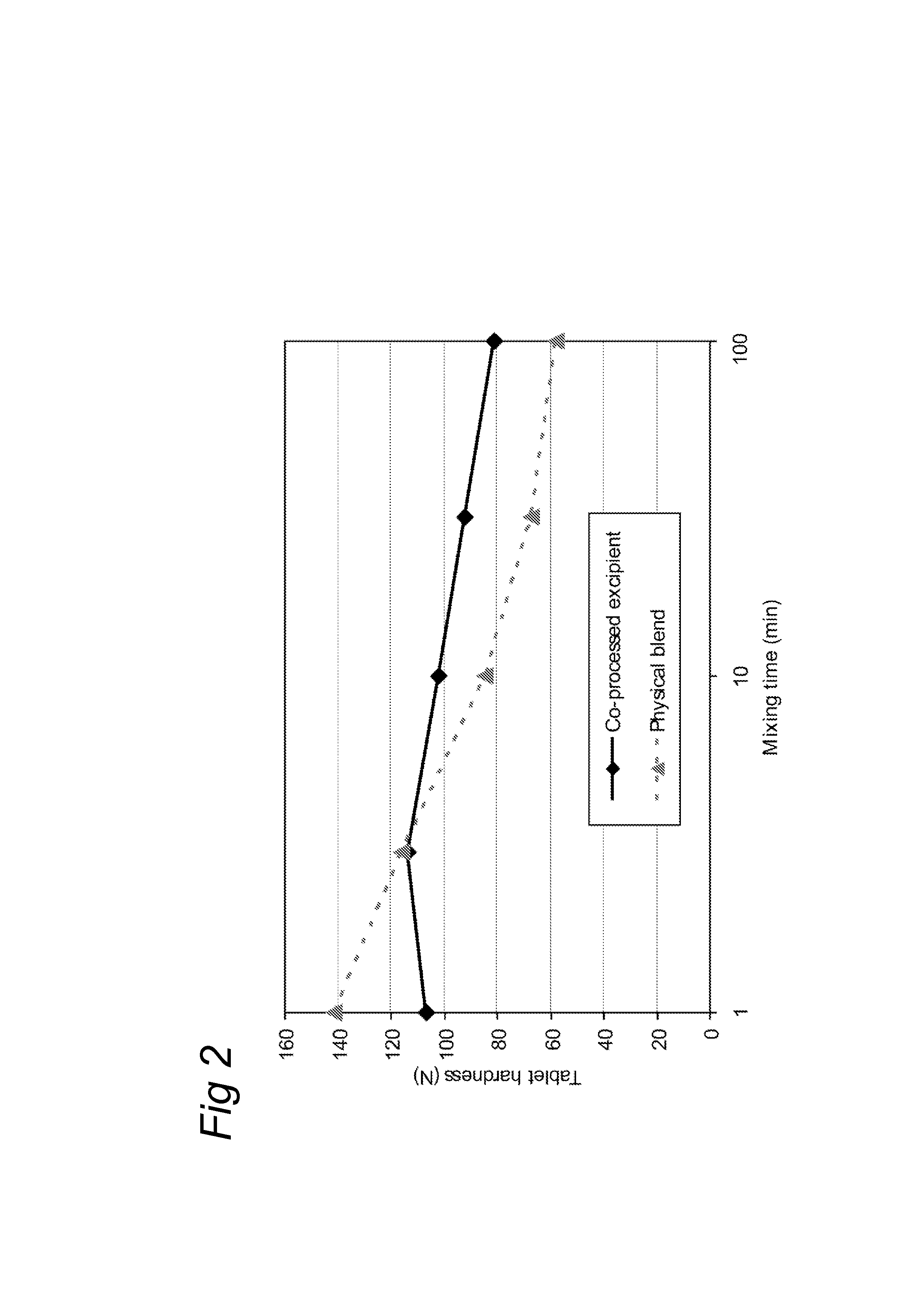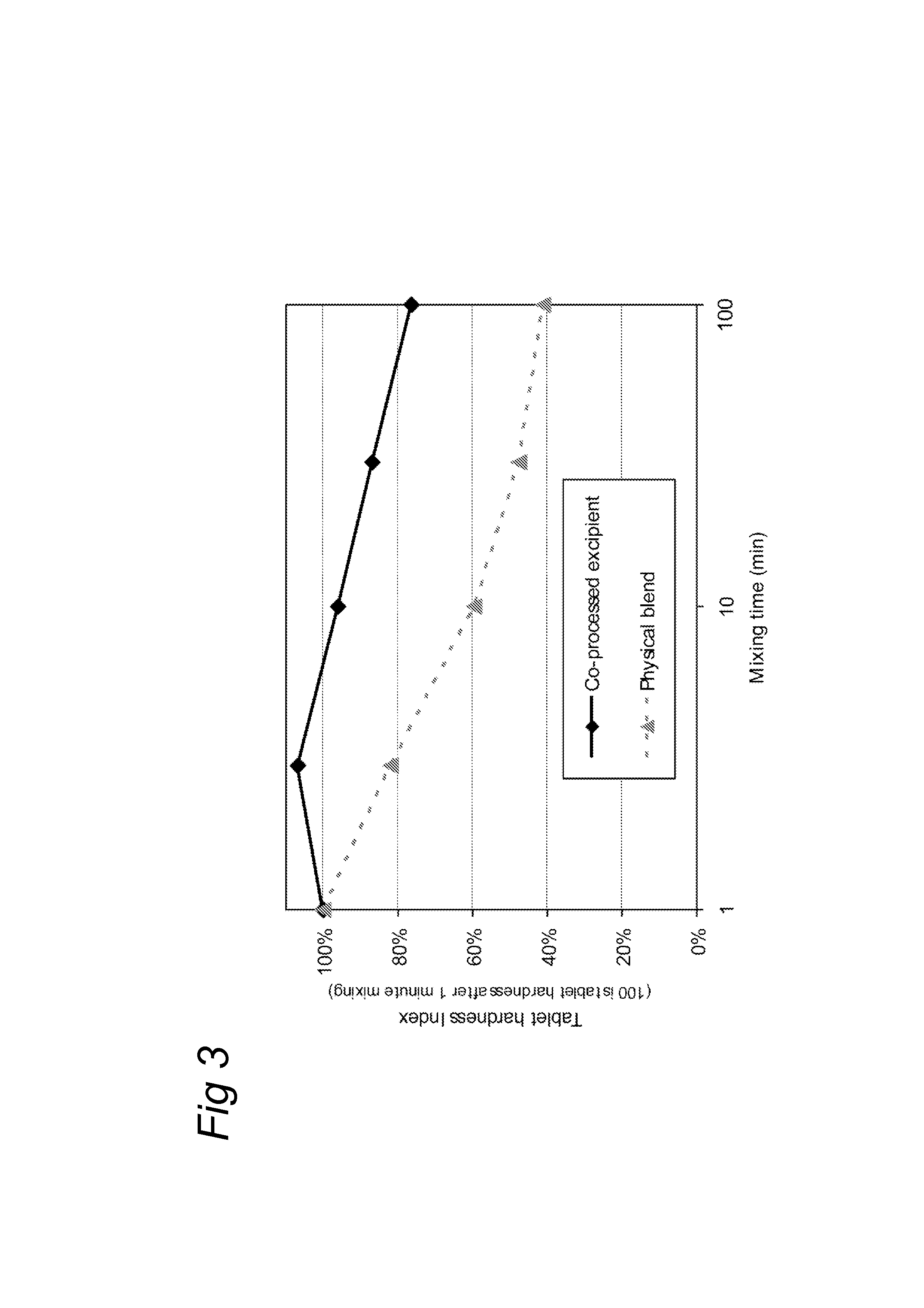Co-processed tablet excipient composition its preparation and use
a technology of excipient composition and coprocessed tablets, which is applied in the directions of pill delivery, coating, and pharmaceutical product form change, can solve the problems of unnecessary lubricant spraying on the excipient components during granulation, and achieve excellent water solubility characteristics and lactose density, and enhance disintegration
- Summary
- Abstract
- Description
- Claims
- Application Information
AI Technical Summary
Benefits of technology
Problems solved by technology
Method used
Image
Examples
example 1
Manufacture of a Co-Processed Excipient Composition
[0034]A co-processed excipient composition was produced by addition of: 261 g Pharmatose® 200M (lactose, a filler / binder, from DFE), 180 g Pharmacel 101® (MCC type, a filler / binder, from DFE), 30 g Primojel® (disintegant, DFE) and 3 g magnesium stearate (lubricant, from Fagron) to a fluid bed agglomerator (Agglomaster AGM-2-PJSD, Hosokawa, Japan) and agglomerating the mixture with 126 g lactose dissolved in 140 ml water. The liquid filler-binder is added to the powder bed over a period of 10 minutes before drying for another 10 minutes. The resulting co-processed excipient is then pre-compressed at a pressure of 10 bar in order to increase the density of the material. It is noted that pre-compressed is not to be confused for the actual tablet compression step at far higher pressures and known to the person skilled in the art.
example 2
[0035]To test the influence of the mixing time on the tablet functionality of the co-processed excipient composition, five separate batches of 500 g co-processed excipient according to example 1 were blended in a Turbula T2C (WAB, Switzerland) for 1, 3, 10, 30 and 100 minutes. In each case, the mixed excipient composition was then compressed with 10 kN force on a Rotab-T (Luxner, Berlin, Germany) rotary press with rotary feed frame into 9 mm, 250 mg tablets. These tablets were left to relaxate before testing the disintegration time and tablet crushing strength the following day.
[0036]As reference, five blends of SuperTab 14SD® (lactose, filler / binder from DFE) with Pharmacel 102® (a MCC type, filler / binder, from DFE) and Primojel® (DFE) were prepared by blending the ingredients in a Turbula T2C (WAB, Switzerland) rotating at 90 RPM for 8 minutes before adding the magnesium Stearate (Fagron, Germany) and mixing for another 1, 3, 10, 30 or 100 minutes. These are referred to a...
example 3
SEM
[0040]To show the influence of the process of the invention, scanning electron microscope (SEM) was used to take pictures. FIGS. 4A-C compare the physically mixed sample (A) with the co-processed excipient (B). FIG. 4C is a magnified version of the co-processed excipient in FIG. 4B.
[0041]FIG. 4A shows the individual particles each having their own characteristics. All are uncoated. The SEM of the co-processed excipient first of all clearly shows the creation of the coarse coat of lactose crystallites and secondly the size enlargement of individual particles resulting from the agglomeration of multiple particles.
PUM
| Property | Measurement | Unit |
|---|---|---|
| Fraction | aaaaa | aaaaa |
| Fraction | aaaaa | aaaaa |
| Fraction | aaaaa | aaaaa |
Abstract
Description
Claims
Application Information
 Login to View More
Login to View More - R&D
- Intellectual Property
- Life Sciences
- Materials
- Tech Scout
- Unparalleled Data Quality
- Higher Quality Content
- 60% Fewer Hallucinations
Browse by: Latest US Patents, China's latest patents, Technical Efficacy Thesaurus, Application Domain, Technology Topic, Popular Technical Reports.
© 2025 PatSnap. All rights reserved.Legal|Privacy policy|Modern Slavery Act Transparency Statement|Sitemap|About US| Contact US: help@patsnap.com



